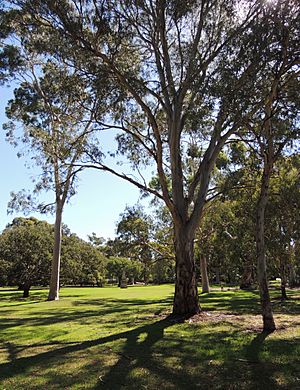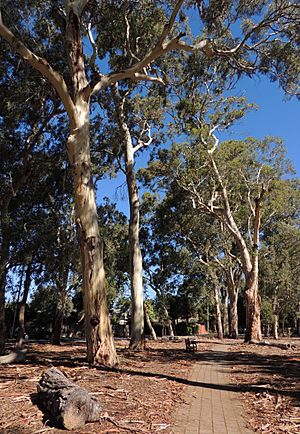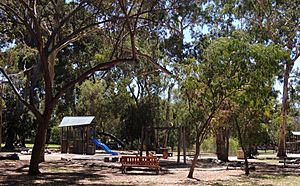Heywood Park facts for kids
Quick facts for kids Heywood Park |
|
|---|---|
| Location | Unley Park, South Australia |
| Area | 3.2 hectares (8 acres) |
| Owned by | City of Unley |
Heywood Park is a public park located in Unley Park, a suburb of Adelaide, South Australia. It's a special place because it has some of the very last Grey Box gum trees (Eucalyptus microcarpa) found on the Adelaide plains. Some of these trees are even older than when Europeans first settled in Australia!
The park got its name from Heywood in Lancashire, England. This was the birthplace of William Haslam, who was the last private owner of the land before it became a park. The local government, known as the City of Unley council, bought the property. Heywood Park officially opened to the public on 10 December 1921. Today, many families and children love visiting the park, especially for its "huge, magnificent, thick-trunked trees."
How Heywood Park Was Created
Back in 1913, the land that is now Heywood Park was a private estate called Heywood. It was owned by Annie Haslam, the wife of William Haslam, who had passed away in 1898. At that time, people saw it as "practically the only park left in the vicinity." There was talk about dividing the property into smaller blocks for building houses. If that had happened, the city of Unley would have lost its chance to have a beautiful public park.
After the Unley council bought the land, they made some improvements. They built public restrooms and planned a big opening ceremony for 10 December 1921. People in the community even held fundraisers to help pay for the work and to host a fun fair on the opening day. In that same year, the Unley Council decided that Heywood Park should be "...preserved in its natural state as a public park." This meant they wanted to keep it looking as natural as possible.
Looking After the Trees
Heywood Park is known for its amazing trees, but sometimes they need special care. In 2003, there was a plan to plant native understorey plants (smaller plants that grow under trees) to help the older, established trees stay healthy. However, many people in the community disagreed with this idea, and the plan didn't go ahead.
The Conservation Council of South Australia wanted to bring back some of the original plants that used to grow in the park. These included plants like golden wattle, native lilac, buttercups, tall bluebells, scented garland lilies, vanilla lilies, and native grasses.
In January 2012, a woman was hurt by falling branches from a gum tree in Heywood Park. This happened on Australia Day when about 200 people were having picnics. The weather was hot and windy that day.
Because of safety concerns, it was announced in 2014 that up to 40 of the park's 200 trees would be removed. This was part of a program to reduce risks from falling branches. Some of these trees are considered "Regulated" or "Significant" under local laws. A regulated tree is very large, with a trunk measuring at least 2 meters around. Significant trees are even bigger, with a trunk measuring 3 meters or more around.
The significant trees planned for removal included two SA Blue Gums (Eucalyptus leucoxylon), a River Red Gum (Eucalyptus camaldulensis), and a Willow Myrtle (Agonis flexuosa). The council planned to put up noticeboards in the park to keep visitors updated on the work, which was expected to happen in 2015.
What You Can Do at Heywood Park Today
As of 2015, Heywood Park is a great place to visit. It has areas for picnics, public restrooms, open lawns, and fun playgrounds for kids. Of course, it also has a wide variety of beautiful, well-established trees that make it a lovely spot for everyone to enjoy.




